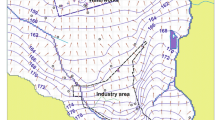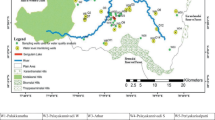Abstract
In recent years, human pharmaceutical substances have been increasingly detected in the aquatic environment. Specific attention has been drawn to the occurrence of pharmaceutical substances at bank filtration sites which are used for drinking water production. In the course of the authorisation application for new pharmaceutical compounds, an environmental risk assessment is required. Currently, the expected concentration of the human pharmaceutical compound in groundwater at bank filtration sites is calculated following the guideline Pre-Authorisation Evaluation of Medicines for Human Use issued by the European Medicines Agency (EMEA 2006). A simple estimation is applied: The predicted environmental concentration (PECGW) is the predicted environmental concentration in surface water (PECSW) multiplied with 0.25. A new approach considering the hydraulic and hydrogeological characteristics of bank filtration sites as well as transport processes is presented in this study. First, a numerical groundwater flow model was developed to simulate the groundwater flow processes at bank filtration sites in general. Flow times were calculated as a function of the hydraulic and hydrogeological parameters: hydraulic conductivity, shore-well distance, screen depth and extraction rate. In a second step, the PECGW was calculated based on the compound concentration in surface water and the modelled groundwater flow times considering linear sorption and first-order decay. Sorption and degradation can only be calculated based on the data provided by the pharmaceutical company in the course of the authorisation application. The current approach following the EMEA guideline invariably connects the PECGW with the PECSW without considering sorption and/or degradation processes. We introduce an approach that incorporates the hydraulic process bank filtration and the main transport processes sorption and degradation. The new approach is compound specific as well as aquifer, flow and transport specific resulting in a more realistic PECGW value compared to the old approach.






Similar content being viewed by others
References
Andreozzi, R., Caprio, V., Ciniglia, C., De Champdore, M., Lo Giudice, R., Marotta, R., et al. (2004). Antibiotics in the environment: Occurrence in Italian STPs, fate, and preliminary assessment on algal toxicity of amoxicillin. Environmental Science & Technology, 38(24), 6832–6838.
Doppler, T., Franssen, H. J. H., Kaiser, H. P., Kuhlman, U., & Stauffer, F. (2007). Field evidence of a dynamic leakage coefficient for modelling river–aquifer interactions. Journal of Hydrology, 347(1–2), 177–187.
EC. (2001). Community code relating to medicinal products for human use, Directive 2001/83/EC. Brussels: European Commission, European Parliament and Council.
Eckert, P., & Irmscher, R. (2004). Modelling of hydrogeochemical processes during bank filtration. In: K. Kovar, Z. Hrkal, & J. Bruthans (Eds.), Proceedings of the international conference on finite element models (pp. 193–196). Karlovy Vary, Czech Republic: Fontainebleau, France, International Association of Hydrologic Sciences.
Eckert, P., & Irmscher, R. (2006). Over 130 years of experience with riverbank filtration in Düsseldorf, Germany. Journal of Water Supply: Research and Technology—AQUA, 55(4), 283–291.
EMEA. (2006). Guideline on the environmental risk assessment of medicinal products for human use, Doc. Ref. EMEA/CHMP/SWP/4447/00. London: European Medicines Agency.
Engelmann, U., & Rohde, S. (2009). Pharmaceutical substances, antibiotics and X-ray contrast media in treated waste water and surface water in the Federal State Saxony (Arzneimittelwirkstoffe, Antibiotika und Röntgenkontrastmittel in Abwassereinleitungen und Oberflächengewässern in Sachsen). KA Korrespondenz Abwasser, Abfall, 56(3), 258–268.
Fenz, R., Blaschke, A. P., Clara, M., Kroiss, H., Mascher, D., & Zessner, M. (2005). Monitoring of carbamazepine concentrations in wastewater and groundwater to quantify sewer leakage. Water Science and Technology, 52(5), 205–213.
Fritz, B. (2003). Natural processes with a high efficiency: bank filtration and water recharge (Natürliche Prozesse mit hoher Effizienz: Uferfiltration und Wasseranreicherung). wwt, 10–11, 10–17.
Grischek, T. (2003). Management of bank filtration sites at the Elbe River (Zur Bewirtschaftung von Uferfiltratfassungen an der Elbe). Habilitation, Technische Universität Dresden Institut für Grundwasserwirtschaft, Dresden.
Halling-Sorensen, B., Nielsen, S. N., Lanzky, P. F., Ingerslev, F., Lutzhoft, H. C. H., & Jorgensen, S. E. (1998). Occurrence, fate and effects of pharmaceutical substances in the environment—a review. Chemosphere, 36(2), 357–394.
Hanisch, B., Abbas, B., Kratz, W., & Schüürmann, G. (2004). Human drugs in aquatic ecosystems: approach for the environmental risk assessment of drug residues (Humanarzneimittel im aquatischen Ökosystem: Bewertungsansatz zur Abschätzung des ökotoxikologischen Risikos von Arzneimittelrückständen). Umweltwissenschaften und Schadstoff-Forschung, 16(4), 223–238.
Heberer, T. (2002a). Occurrence, fate, and removal of pharmaceutical residues in the aquatic environment: A review of recent research data. Toxicology Letters, 131(1–2), 5–17.
Heberer, T. (2002b). Tracking persistent pharmaceutical residues from municipal sewage to drinking water. Journal of Hydrology, 266(3–4), 175–189.
Hiscock, K. M., & Grischek, T. (2002). Attenuation of groundwater pollution by bank filtration. Journal of Hydrology, 266(3–4), 139–144.
HYDOR (2004). Hydrological evaluation of the groundwater resources of the water works Tegel, Spandau, Tiefwerder, Kladow and Beelitzhof in Berlin (Hydrologische Berechnungen zum Nachweis des Grundwasserdargebotes für die Wasserwerke Tegel, Spandau, Tiefwerder, Kladow und Beelitzhof der Berliner Wasserbetriebe). Unpublished report, Berliner Wasserbetriebe, Berlin.
HYDOR (2007). Hydrological evaluation of the groundwater resources of the water works Friedrichshagen, Altglienicke, Johannisthal, Wuhlheide, Kaulsdorf und Buch in Berlin (Hydrologische Berechnungen zum Nachweis des Grundwasserdargebotes für die Wasserwerke Friedrichshagen, Altglienicke, Johannisthal, Wuhlheide, Kaulsdorf und Buch der Berliner Wasserbetriebe). Unpublished report, Berliner Wasserbetriebe, Berlin.
Kunkel, U., & Radke, M. (2008). Biodegradation of acidic pharmaceuticals in bed sediments: Insight from a laboratory experiment. Environmental Science & Technology, 42(19), 7273–7279.
Lenk, S., Remmler, F., Skark, C., & Schulte-Ebbert, U. (2006). Technical concepts and adjusted operational modes for an optimal adaptation of riverbank filtration to local boundary conditions (Technische Konzepte und abgestimmte Betriebsweisen zur optimalen Anpassung der Uferfiltration an lokale Randbedingungen). Schwerte: Institut für Wasserforschung GmbH Dortmund.
Liebig, M., Moltmann, J. F., & Knacker, T. (2006). Evaluation of measured and predicted environmental concentrations of selected human pharmaceuticals and personal care products. Environmental Science and Pollution Research, 13(2), 110–119.
Loeffler, D., Rombke, J., Meller, M., & Ternes, T. A. (2005). Environmental fate of pharmaceuticals in water/sediment systems. Environmental Science & Technology, 39(14), 5209–5218.
Massmann, G., Heberer, T., Grützmacher, G., Dünnbier, U., Knappe, A., Meyer, H., et al. (2007). Drinking-water production in urban environments—bank filtration in Berlin (Trinkwassergewinnung in urbanen Räumen—Erkenntnisse zur Uferfiltration in Berlin). Grundwasser, 12, 232–245.
Massmann, G., Nogeitzig, A., Taute, T., & Pekdeger, A. (2008a). Seasonal and spatial distribution of redox zones during lake bank filtration in Berlin, Germany. Environmental Geology, 54, 53–65.
Massmann, G., Sültenfuß, J., Dünnbier, U., Knappe, A., Taute, T., & Pekdeger, A. (2008b). Investigation of groundwater residence times during bank filtration in Berlin: A multi-tracer approach. Hydrological Processes, 22, 788–801.
OECD. (2000). OECD guidelines for the testing of chemicals/Section 1: Physical–chemical properties test no. 106: Adsorption–desorption using a batch equilibrium method. Paris: Organisation for Economic Co-operation and Development.
OECD. (2002). OECD guidelines for the testing of chemicals/Section 3: Degradation and accumulation test no. 308: Aerobic and anaerobic transformation in aquatic sediment systems. Paris: Organisation for Economic Co-operation and Development.
Ray, C., Melin, G., & Linsky, R. B. (Eds.). (2002). Riverbank filtration—improving source-water quality. Dordrecht: Kluwer Academic.
Scheytt, T., Mersmann, P., & Heberer, T. (2006). Mobility of pharmaceuticals carbamazepine, ibuprofen, diclofenac, ibuprofen, and propyphenazone in miscible-displacement experiments. Journal of Contaminant Hydrology, 83, 53–69.
Scheytt, T., Mersmann, P., Leidig, M., Pekdeger, A., & Heberer, T. (2004). Transport of pharmaceutically active compounds in saturated laboratory columns. Ground Water, 42(5), 767–773.
Schmidt, C. K., Lange, F. T., & Brauch, H.-J. (2004). Assessing the impact of different redox conditions and residence times on the fate of organic micropollutants during riverbank filtration. In R. Gimbel, N. Graham, & M. R. Collins (Eds.), Recent progress in slow sand and alternative biofiltration processes (pp. 561–569). London: IWA.
Schubert, J. (2002). Hydraulic aspects of riverbank filtration—field studies. Journal of Hydrology, 266, 145–161.
von Keutz, E., & Jekat, F.-W. (1998). Toxicological studies in the course of a marketing authorization application for human pharmaceuticals (Toxikologische Untersuchungen im Rahmen der Zulassung von Humanarzneimitteln). In Hessische Landesanstalt für Umwelt (Ed.), Arzneimittel in Gewässern (pp. 65–69). Wiesbaden: Hessische Landesanstalt für Umwelt.
Zippel, M., Scheytt, T., Hannappel, S., & Müller, B. (2009). Mathematical transport simulation of pharmaceutical compounds in groundwater during bank filtration (Mathematische Simulation des Eintrages von Arzneimitteln aus Oberflächengewässern in das Grundwasser durch Uferfiltration). In Umweltbundesamt (Ed.), Texte 14/2010 (p. 162). Dessau: Umweltbundesamt.
Acknowledgement
This work was funded by the German Federal Environment Agency (Umweltbundesamt). We would like to thank the following institutions which provided hydraulic and hydrogeological data on bank filtration sites as well as concentration data of pharmaceutical substances in groundwater: Kompetenzzentrum Wasser Berlin, Stadtwerke Düsseldorf, Hochschule für Technik und Wirtschaft Dresden (FH), Fernwasserversorgung Elbaue-Ostharz GmbH Torgau and Technologiezentrum Wasser (TZW) Karlsruhe.
Author information
Authors and Affiliations
Corresponding author
Additional information
The use of brand names in peer-reviewed papers is for identification purposes only and does not constitute endorsement by the authors and their employers.
Rights and permissions
About this article
Cite this article
Müller, B., Scheytt, T., Zippel, M. et al. A New Approach to Calculate EMEA’s Predicted Environmental Concentration for Human Pharmaceuticals in Groundwater at Bank Filtration Sites. Water Air Soil Pollut 217, 67–82 (2011). https://doi.org/10.1007/s11270-010-0568-9
Received:
Accepted:
Published:
Issue Date:
DOI: https://doi.org/10.1007/s11270-010-0568-9




